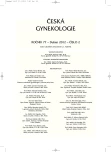Possibilities of IVF in native cycle
Authors:
V. Paseková; T. Mardešić
Authors‘ workplace:
Sanatorium Pronatal, Praha, vedoucí lékař doc. MUDr. T. Mardešić, CSc.
Published in:
Ceska Gynekol 2012; 77(2): 175-178
Category:
Original Article
Overview
Objective:
To evaluate the benefits and possibilities of the native cycle and / or minimal stimulation with subsequent use of methods of in-vitro fertilization.
Type of study:
Overview.
Setting:
Pronatal, sro, Prague.
Methods and results:
Native or modified cycles with minimal stimulation now experiencing a renaissance, mainly due to the onset of antagonists of gonadoliberines. Except for the standard controlled ovarian hyperstimulation protocols we use for acquiring of oocyte other different methods – free native cycles, ovulation induction with antiestrogens and / or adding the minimum doses of gonadotropins. Concomitant use of antagonists prevents premature peak of luteinizing hormone, that was previously characteristic for these procedures. Native cycles we can use virtually for all the factors of infertility. Pregnancy rate per cycle is about 17%, but the cumulative pregnancy rate after three consecutive cycles reaches over 30%.
Conclusion:
Native cycle and its current modifications and subsequent in vitro fertilization offers the benefit of minimal consumption of drugs and the practical absence of side effects. It is characterized by short duration, lower price and the possibility of repetition each month. Virtually eliminates the occurrence of multiple pregnancies. Its efficiency is however limited and is characterized by a high number of cancellations. The cumulative pregnancy rate per embryo transfer is comparable with pregnancy rate of conventional stimulation protocols.
Key words:
native cycle, minimal stimulation, in-vitro fertilization.
Sources
1. Baroni, E., Ubaldi, F., Rienzi, L., et al. Hopes and facts about mild ovarian stimulation. Reprod Biomed Online, 2007, 14(6), p. 675–681.
2. Bensdorp, AJ., Slappendel, E., Koks, C., et al. The INeS study: prevention of multiple pregnancies: a randomised controlled trial comparing IUI COH versus IVF e SET versus MNC IVF in couples with unexplained or mild male subfertility. BMC Womens Health, 2009, 18, p. 35.
3. Edwards, RG. IVF, IVM, natural cycle IVF, minimal stimulation IVF – time for a rethink. Reprod Biomed Online, 2007, 15(1), p. 106–119.
4. Weissman, A., Howles, CM. Treatment strategies in assisted reproduction for the low responder patient. In: Gardner, DK., Weissman, A., Colin, MH., Shoham, Z. Textbook of Assisted Reproductive Technologies. Laboratory and Clinical Perspectives. 3rd Ed. Informa Healthcare, UK, London, 2009.
5. Paseková, V., Mardešić, T. , Vobořil, J., et al. Přenos jednoho embrya (single embryo transfer): možnosti a limity. Čes Gynek, 2011, 76, 5, s. 390–400.
6. Pelinck, MJ., Vogel, NEA., Hoek, A., et al. Minimal stimulation IVF with late folicular phase administration of the GnRH antagonist cetrorelix and concomitant substitution with recombinant FSH: a pilot study. Hum Reprod, 2005, 20, p. 642–648.
7. Rongieres-Bertrand, C., Olivennes, F., Righini, C. Revival of the natural cycles in in vitro fertilization with the use of a new gonadotrophin – releasing hormone antagonist /cetrorelix/: a pilot study with minimal stimulation. Hum Reprod, 1999, 14, p. 683–688.
8. Ubaldi, F., Rienzi, L., Baroni, E., et al. Hopes and facts about mild ovarian stimulation. Reprod Biomed Online, 2007, 14(6), p. 675–681.
Labels
Paediatric gynaecology Gynaecology and obstetrics Reproduction medicineArticle was published in
Czech Gynaecology

2012 Issue 2
Most read in this issue
- Triple negative breast cancer – prognostically highly unfavourable group cancer of breast
- Possibilities of IVF in native cycle
- Urinary tract infections in pregnancy: when to treat, how to treat, and what to treat with
- Vaginal birth after previous caesarian section – outcomes analysis 2007–2010
